
As the tech landscape transforms in 2024, businesses face the challenge of keeping their workforce equipped with the latest skills. There are three main strategies that businesses can use to address this challenge: upskilling, reskilling, and hiring skilled employees.
Moreover, as AI automates tasks previously handled by humans, new skill demands arise. To remain at the forefront, businesses must ensure their workforce is adept at AI collaboration and equipped with necessary skills.
Skill Success, one of the top online learning platforms, aimed to understand the trends, benefits, and challenges associated with upskilling, reskilling, and hiring. To do this, we conducted a comprehensive survey and interviews.
The data for this report was collected from a representative sample of 320 lifelong learners from different places, with the majority from the United States and some from other parts of the world. The platform has over 500,000 students and 4000 courses. The population consists of professionals, career builders, and entrepreneurs learning business, professional development, technology, and more.
We’ve also gathered insights from industry experts such as HR professionals, talent acquisition specialists, and executives with experience in workforce development.
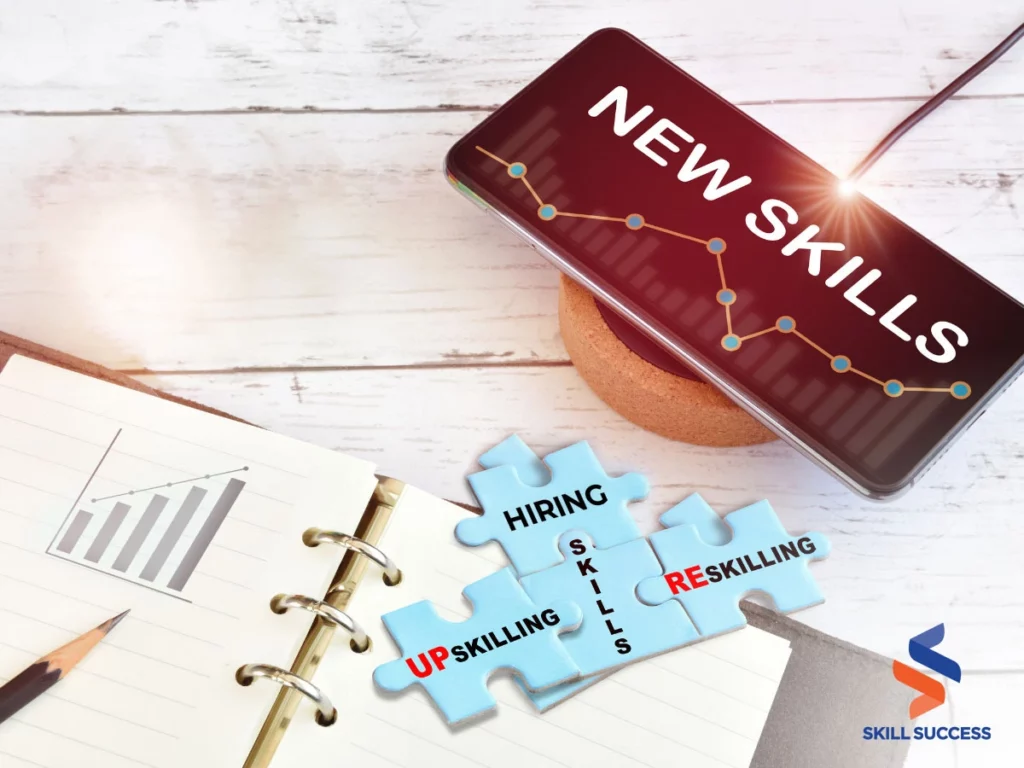
Upskilling: Developing Existing Talent
Upskilling is the process of teaching existing employees new skills. This can be done through training courses, online learning, or on-the-job experience. Upskilling is important because it helps employees stay relevant in their field and avoid being replaced by automation.
There are many benefits to upskilling, including:
- Improved employee retention and morale
- Cost-effectiveness compared to hiring
- Faster integration of updated skills into existing company culture
During our interviews, Ankit Dhadwal, Director at Mount Shine, highlighted the compelling reasons why upskilling is a highly effective approach for businesses, especially for small businesses:
“In my current situation, as a small business owner, upskilling existing employees is the best way to match and adapt to new technologies and industry changes. It will create a win-win situation as I don’t have to train a new employee with our workflow... Hiring new employees will be expensive as we already invest in new technology, which can add budget constraints."
Ankit further emphasized that upskilling not only gives our employees new skills, but it also makes them feel trusted and motivated. Employees recognize the company's commitment to their growth and development, leading to a profound sense of loyalty.
Lastly, his perspective on our possible expansion into a larger company adds valuable insights. His proposed method of incorporating upskilling, reskilling, and hiring achieves a well-rounded approach. This strategy would enable us to gain new skills while also appreciating and improving the abilities of our current team.
Reskilling: Transitioning Employees into New Roles
Reskilling is the process of teaching employees new skills that are different from their current ones. It is a valuable way to help employees adapt to change and stay competitive in the job market.
Phil Portman, the CEO of Textdrip, graciously shares his valuable insights to Skill Success. Among these, he highlights a noteworthy perspective on the concept of reskilling.
"When significant shifts in technology or industry occur, reskilling can help current employees transition into new roles. This is particularly effective when the company has a strong commitment to employee growth and development."
There are many benefits to reskilling, including:
- Retaining institutional knowledge and experience
- Demonstrating a commitment to employees' growth and development
- Adapting to changing industry demands without external hiring
Hiring Skilled Employees: Meeting Immediate Skill Requirements
Hiring skilled employees is the process of bringing in new employees who already have the skills that the business needs. Quiet hiring became much more popular this year as it offers a quick way to fill skill gaps and get the business up and running
There are many benefits to hiring skilled employees, including:
- Immediate integration of required skills
- Fresh perspectives and diverse experiences
- Addressing urgent skill gaps that may not be feasible with upskilling/reskilling alone
To better understand when hiring is more suitable than upskilling or reskilling, let's hear from Kirsten Zeigler, a Human Resources expert:
"Hiring outside of your company could be needed for a few reasons. One is if you require more years of experience than those internally have, or if there is continuing education or licensure needed that your team does not have. A great way to retain talent is to provide education and learning support to grow team members, but you may need to fill a role more urgently than being able to wait for someone to go through a program. Another reason would be a different type of experience that's provided. Unfortunately, that couldn't be upskilled on your team."
Kirsten also suggests that you should first consider your existing employees and understand their goals so you can guide their development in the right direction.

Factors to Consider When Choosing Between Upskilling, Reskilling and Hiring
Among the factors influencing decisions between upskilling, reskilling, and hiring, the Skill Success survey highlighted three primary considerations. A majority of respondents placed significant emphasis on the availability of training resources, with 146 participants highlighting its importance. Cost-effectiveness was also a major consideration for 116 participants, followed closely by time constraints, which were cited by 101 participants.
Additionally, some participants also considered factors such as the availability of qualified candidates in the job market, loyalty to existing employees, company culture fit, and the speed of adapting to changes when making these strategic workforce decisions.
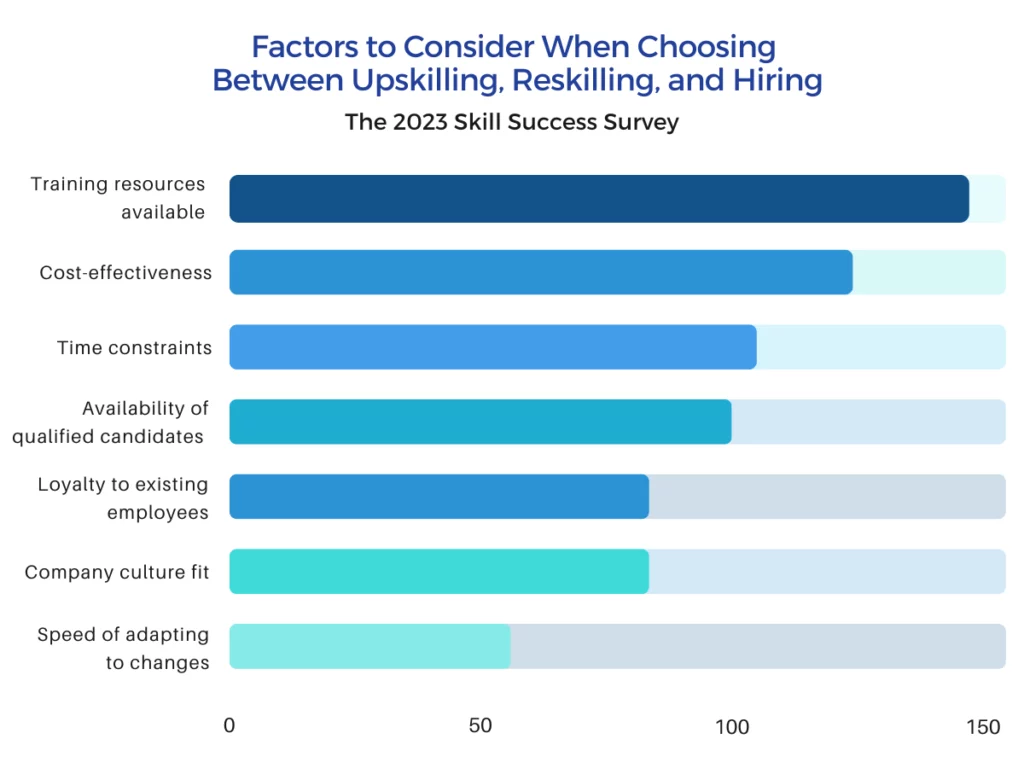
Here are some statements from the experts we've interviewed on their insights and tips about these factors:
Training Resources Available
Maximize the potential of your internal training resources by prioritizing upskilling and reskilling, and ensure a harmonious fit between employee career goals and business needs through purposeful discussions.
"If you already have robust internal training resources, this can be a significant argument for upskilling and reskilling... Survey employees on their career goals; align their ambitions with business needs when considering reskilling."
Cost-effectiveness and company culture fit
According to Shri Ganeshram, CEO of Awning.com, hiring new talent is exciting, but there's an onboarding time, and they need to mesh with your culture. Existing employees already fit the bill, and their upskilling can be cost-effective in the long run. He suggests:
"Understand the career trajectory of your employees. If upskilling aligns with their aspirations, they're more likely to be invested... Assess the skills of your team periodically. You might find hidden talents or recognize glaring gaps."
Time Constraints
Ricky Gomulka, Founder and Managing Partner of JetLevel Aviation, advises considering hiring new employees, especially when time is limited.
"If the business needs to adapt to new technologies or industry changes quickly, then hiring new employees may be the best option."
He also emphasizes that evaluating unique requirements and situations remains the key in effectively embracing new technologies and industry shifts.

Evaluating Your Skill Pipeline's Potential: A Crucial Consideration for Upskilling, Reskilling, or Hiring
Beyond the factors mentioned earlier, a significant determinant for choosing between employee development/reskilling and new talent hiring hinges on the availability of necessary skills and potential within your current workforce. According to Nick Shaw, Co-founder of Spotted Zebra:
"If you have a good understanding of the skills that your current workforce possesses and the skills that your current and future opportunities require, you can develop a skills pipeline to avoid any damaging skills gaps."
Nick suggests a three-fold approach:
- Identify future-required skills and critical vacant roles for proactive employee development. Read more: 12 Must-Have Skills for Business
- Evaluate staff in roles becoming obsolete, considering reskilling potential for available opportunities.
- If internal talent is insufficient for current roles or time is pressing, consider external hiring.
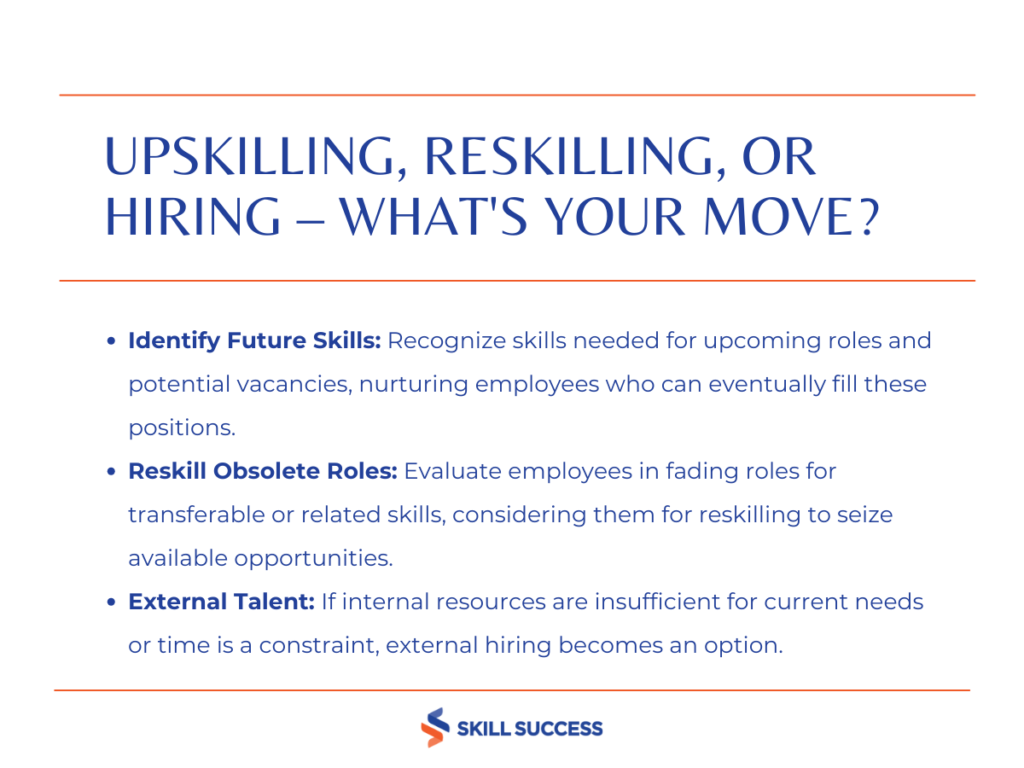
Explore these essential soft skills that can significantly impact your upskilling, reskilling, and hiring strategies:
- Top Leadership Skills to Learn
- Negotiation Skills and Strategies for Business
- Improving Critical Thinking for Business
- How to Develop Your Networking Skills
- Driving Innovation and Creativity for Business
- How to Boost Your Strategic Planning Skills
- How to Master Emotional Intelligence
Effective Adaptation: Upskilling, Reskilling or Hiring?
Skill Success spoke to employees and professionals in different fields. We asked them the pivotal question: "Which approach is most effective for businesses looking to adapt to new technologies and industry changes?" This question aims to reveal insights that guide the best paths to success in a quickly changing environment.
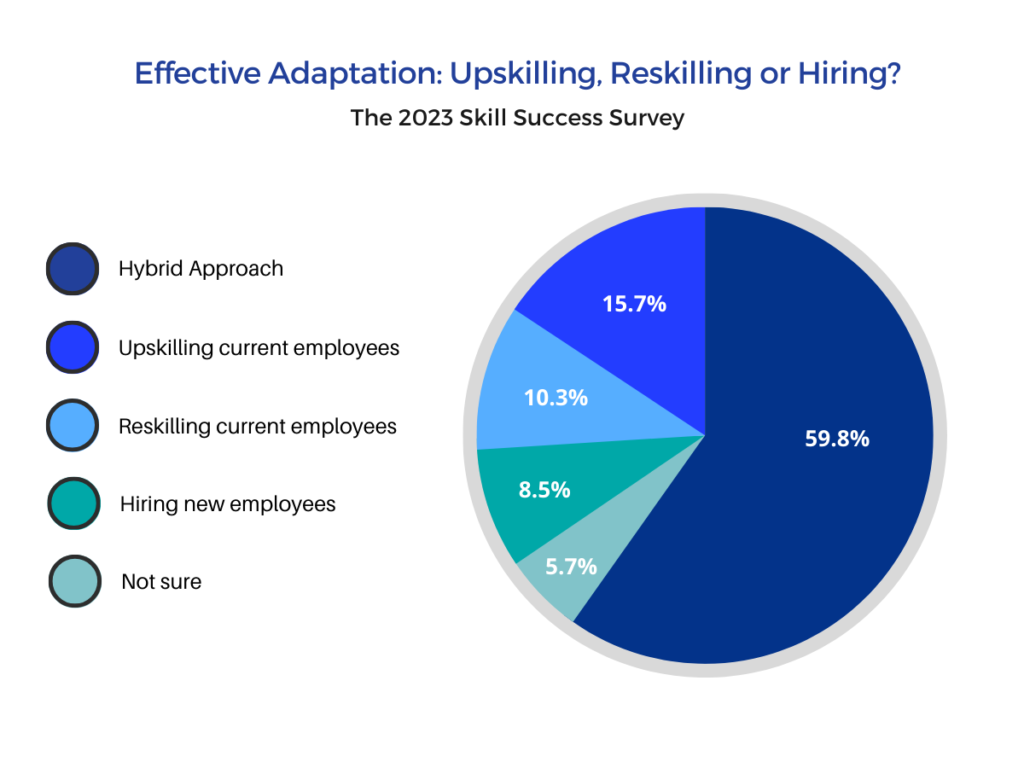
The survey results highlight a preference for a combination of upskilling, reskilling, and hiring, representing 59.8% of the responses. Upskilling current employees stands at 15.7%, while reskilling follows at 10.3%. A smaller proportion, 8.5%, leans toward hiring new employees with the necessary skills. Those who are unsure about the preferred approach constitute 5.7% of the responses.
With these statistics in mind, let's now look at the insights shared by industry experts:
"A combination of upskilling, reskilling, and hiring is the most effective for businesses looking to adapt to new technologies and industry changes. Ever-evolving and rapid market demands need a constant update of employee skills. This understanding is an indispensable requirement to be competitive in the market, and also to come up with innovative solutions that aptly address market gaps. This cannot be done by focusing only on one specific employee upgrading strategy. Depending on the specific goals, businesses need to focus on upskilling, reskilling, and diverse hiring practices simultaneously so that they can successfully adapt to new technologies and industry changes..."
"The best strategy combines upskilling, reskilling, and hiring for two fundamental reasons: closing a skills gap and increasing employees' internal mobility, hence their retention. Reskilling and upskilling are crucial for maintaining employees who have built a company's culture over time. Reskilling and hiring are meant to expand the pool of skills among employees. Through reskilling and hiring, a company ensures employees have the relevant skills needed in a changing job environment."
"Upskilling current employees is the most important for businesses to stay on top of changing technology and other industry changes. The reason for this is because with how rapidly things are changing, it’s crucial for employees to have the skills they need to adapt to new ways of working driven by technology."
"If you plan to grow aggressively, you should lean into hiring more heavily than upskilling and reskilling so you can build your team quickly. Still, you should never ignore investing in the team you already have because if a strong focus on hiring makes employees feel neglected and passed over for promotions and opportunities, you’ll face a growing retention problem. Create separate strategies for each, revisiting and rebalancing which method you prioritize as your business grows and needs shift."
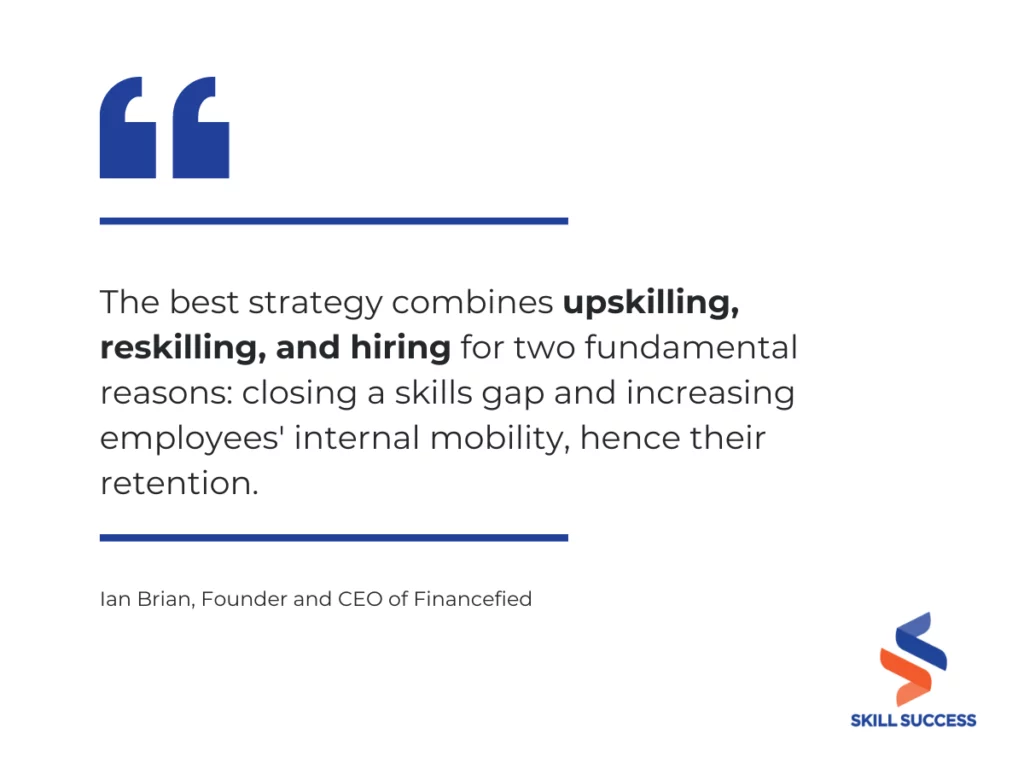
Challenges in Implementing Upskilling and Reskilling Programs
In our interviews, it became evident that prioritizing upskilling and reskilling over hiring is a prevalent trend among businesses seeking to bolster their workforce capabilities.
The next discussion provides a comprehensive look into the common challenges organizations encounter when integrating successful upskilling and reskilling programs.
Result: Finding suitable training resources/providers ranked highest (264 respondents), followed by allocating training budget (191 respondents), while prioritizing skills (144 respondents) and overcoming employee resistance (130 respondents) reflected complexities. Balancing work with training (130 respondents) and high employee turnover (85 respondents) were also significant hurdles.
Note: The analysis is based on responses from 320 participants who chose multiple answers.
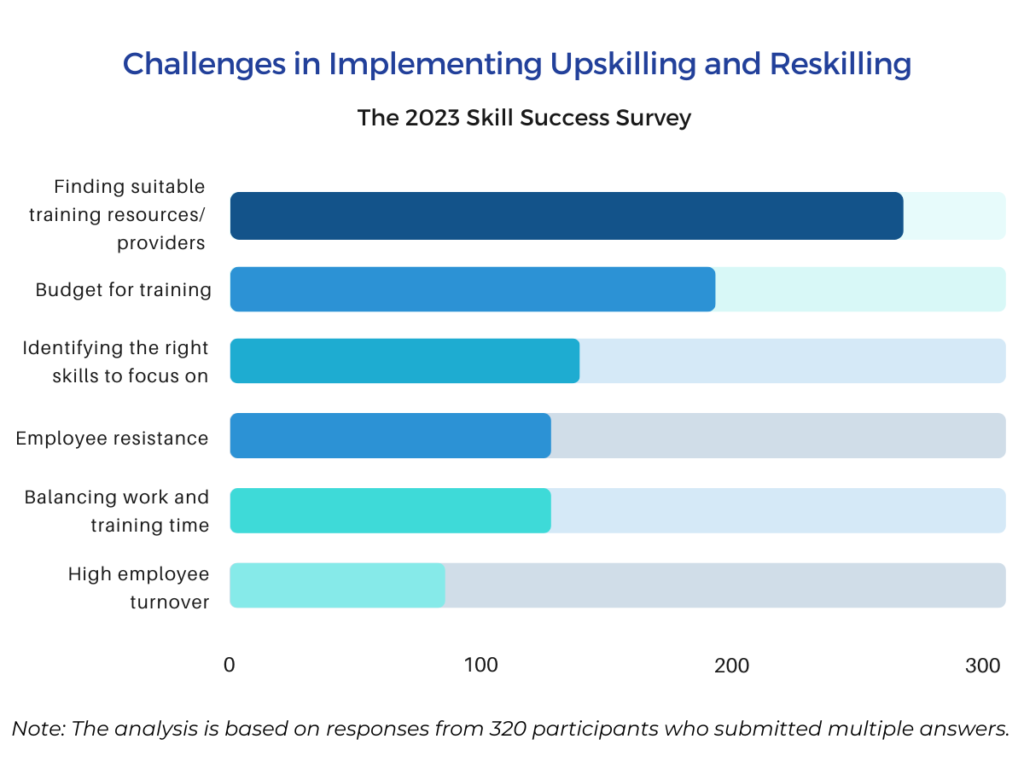

Expert Roundup: Tips to Address Upskilling and Reskilling Challenges
Finding suitable training resources / providers
"Robust mentoring is one of the best options for it. Most employees prefer to have their seniors as their mentors. These seniors will offer guidance without causing any discomfort. Moreover, they can quickly identify the employees' skill gaps through the program. It will facilitate the learning process faster."
"The internet is flooded with training programs, not all of which are beneficial. Seek recommendations, read reviews, and consider trial periods."
Allocating Budget for Training
“Continuously evaluate the return on investment (ROI) of the training and development initiatives. Assess the impact of the skill-building efforts on employee performance, productivity, and overall business outcomes. This evaluation can help refine future training strategies and ensure that resources are allocated effectively.”
"Organizations can explore cost-effective training options such as online courses, microlearning modules, or partnering with educational institutions for customized training programs."
Addressing Employee Resistance
"Any change to the status quo may shake a few of your employees out of their comfort zones. That's okay. Encourage them to push their comfort zones and incentivize them through rewards to participate in upskilling and reskilling programs."
"This can be overcome by integrating learning programs into performance measures and rewarding employees for skill improvement."
"Communication must be clear, consistent, and concise to manage resistance to change. When implementing change, it is essential to listen and integrate employee perspectives during the process, as their input can lead to solutions better aligned with actual upskilling needs."
Identifying the Right Skills to Focus On
"It is important to have a detailed analysis of market trends and project future needs. Regular 'skills gap analysis' can go a long way in this."
Balancing Work and Training Time
"Upskilling or reskilling employees is critical, but it should not affect the business's regular work schedules. Therefore, I advise having separate batches for training to ensure regular work is not affected."
"Many employees may feel extra pressure to handle work and training side by side. The best option in such situations is offering flexible work and training hours. Don't overwhelm the employees with irrational demands. They should not detest the training process. Instead, they should look forward to it. Always have a balanced approach between the two responsibilities. While fixing work and training hours, consider and encourage employees' input. It will be best if the employees choose the timings according to convenience."
Dealing with High Turnover
"If there is a significant employee turnover rate, businesses may have trouble implementing programs. The best way to deal with this is to foster a culture at work that emphasizes employee development and positivity."
"No employee will leave because their company is investing in upskilling them. They will go for other reasons. Identify these other reasons and plan to minimize them while constantly upskilling your people." -
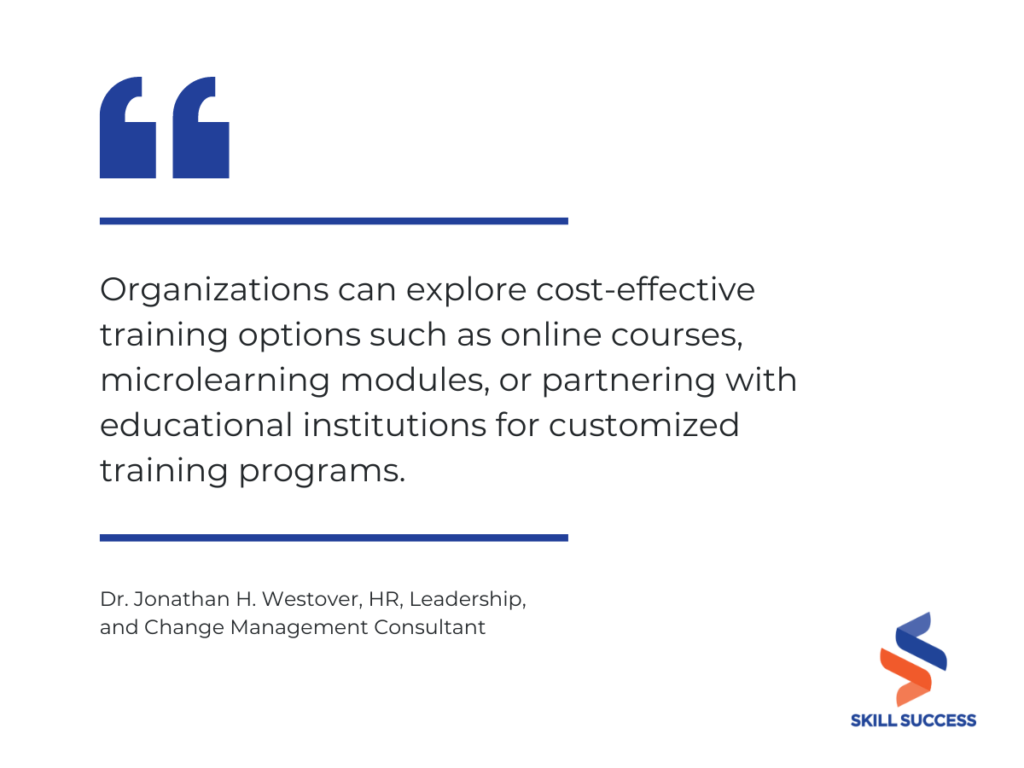
Evolving with AI: The Essential Need for Continuous Skill Development
The fast pace of AI-driven changes demands flexible skill sets, including technical skills and essential soft skills like leadership, adaptability, critical thinking, and effective communication.
Skill Success surveyed industry leaders and employees to understand the significance of continuous learning and skill development in the rapidly changing business landscape influenced by AI.
Results: 89.5% of respondents find lifelong learning extremely or very important, highlighting the unanimous recognition of its value. 9.7% find it moderately important, while only 0.7% see it as not important. This consensus underscores the vital role of ongoing learning in empowering employees within an AI-driven environment.
We also surveyed participants regarding the importance of focusing on AI-related skills when helping employees learn new skills or enhance existing ones. The top three responses were:
- Yes, AI skills are important for future job opportunities: 240 responses
- Yes, but only for specific job roles: 144 responses
- Neutral, AI skills should be balanced with other skills: 191 responses
The remaining responses were divided between "No, AI skills are not a top priority" with a minor percentage, and "I'm not sure" accounting for a smaller percentage.
These insights provide a clear picture of the majority view on the significance of AI-related skills in the context of upskilling and reskilling efforts.
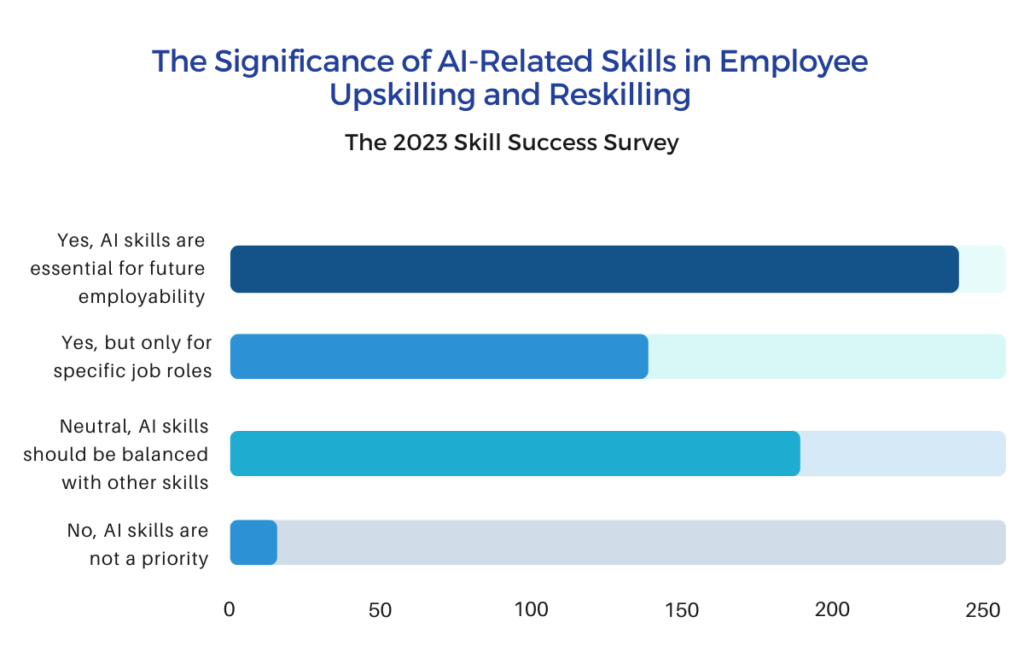
In this era, continuous skill development isn't just a choice; it's a must. It empowers businesses to harness AI's potential and prepares individuals for a future where AI takes center stage. Here are more insights from experts:
"When considering upskilling or reskilling, AI-related skills should indeed be a priority for employees. AI is transforming various industries, and having AI-related skills can significantly enhance employability. From my experience, businesses are increasingly relying on AI technologies for automation, data analysis, and decision-making processes. Therefore, employees with AI-related skills are more likely to be in high demand and have better career prospects."
"It's important to have a tight decision-making loop between your current workers' day-to-day tasks and the upskilling you offer. Vague education about possible uses of AI is much less effective than directed, grounded instruction that uses actual work as its teaching material. Any new products or tools that are worked into upskilling programs should be thoroughly vetted by IT, management, and existing employees for usefulness and applicability first."

Top Recommendations: AI Online Courses with Certificates
ChatGPT Masterclass: The Complete Guide To Using ChatGPT
Employees can benefit from ChatGPT in several ways. It helps generate ideas, aids in writing content, and speeds up tasks like finding information. It can also automate routine work, freeing up time for important tasks. ChatGPT improves communication and makes interactions clearer.
Employees can boost productivity, enhance communication, and improve their work efficiency by learning this powerful AI tool.
This course covers everything from getting started with ChatGPT to using it effectively in various applications. You'll learn how to create an account, understand its capabilities, and explore different prompts.
Take this courseArtificial Intelligence In Digital Marketing
This online course offers valuable benefits for employees across various roles and professions, particularly those involved in digital marketing.
This course is a comprehensive resource that unveils the ways AI is revolutionizing digital marketing. It's ideal for anyone curious about how AI is reshaping this industry. You'll gain insights into Google's shift towards AI-first approaches, grasp the concept of programmatic advertising, and understand the impact of predictive analytics.
The course content covers a range of topics, including predictive analytics, chatbots, algorithmic web design, and programmatic advertising.
Take this courseArtificial Intelligence In Accounting
This course is beneficial for a wide range of people, especially those in finance and accounting fields. For managers aiming to upskill their teams, this course provides a deeper understanding of how AI can be applied in accounting and finance. It's also beneficial for those who want to analyze financial data for better business decisions.
You'll explore how AI can be harnessed to analyze financial data, detect patterns, and predict future outcomes. The curriculum delves into automating accounting tasks like data entry, account reconciliation, and financial statement preparation. You'll discover the role of AI in managing risks, such as credit, market, and operational risks.
Furthermore, the course introduces how AI can aid in budget creation, management, and adjustments. With practical examples and a user-friendly approach, this course equips you with the skills to leverage AI effectively in the field of accounting.
Take this courseChatGPT, Midjourney And DALL-E Essentials: AI 3 In 1 Course
This course offers significant benefits for employees across various levels of expertise. It caters to beginners with no prior AI experience, experts transitioning to ChatGPT and Midjourney, as well as intermediate AI users looking to enhance their skills.
From understanding and utilizing ChatGPT to advanced interactions, freelancing, and enhancing productivity with Microsoft Excel, the course offers practical insights applicable to various professional scenarios. Moreover, the course explores Midjourney and DALL-E, guiding learners in crafting images, improving quality, and maximizing these tools.
Take this courseInside Skill Success: Expert Insights and Practices
At Skill Success, we believe that upskilling and reskilling form the bedrock of success for our employees and play a pivotal role in attaining our business objectives.
Yugie Casal-Trinidad, the General Manager of Skill Success, graciously imparts her invaluable insights on this matter.
How do you perceive the role of upskilling and reskilling in shaping our company's competitive advantage and future growth?
- Increased efficiency and productivity: By upskilling and reskilling our employees, we can ensure that they have the skills and knowledge they need to do their jobs more efficiently and productively. This can lead to increased profits and market share.
- Improved innovation and creativity: When employees are constantly learning and growing, they are more likely to come up with new ideas and solutions to problems. This can help us stay ahead of the competition and create new products and services.
- Reduced turnover: Employees who are given the opportunity to upskill and reskill are more likely to be satisfied with their jobs and less likely to leave the company. This can save us money on recruiting and training costs.
"Here at Skill Success, we have been actively encouraging our team members to upskill and/or reskill by enrolling to our Individual Career Development Program, which helps individuals set goals, track milestones, and achieve career growth. Ultimately, I believe investing in it has helped our company and the team to stay ahead of the curve, lower attrition and maintain a competitive edge in the marketplace."
What is your vision for the future workforce of our company? How do upskilling and reskilling play a role in aligning our team with upcoming challenges and opportunities?
We envision a future workforce that is constantly learning and growing. We want our employees to have the skills and knowledge they need to succeed in an ever-changing world. We also want them to be creative and innovative, and to be able to think outside the box.
"I firmly believe that the strength of the whole comes from the resourcefulness, resilience and adaptability of each individual and encouraging our team to take risks and aim higher is essential in achieving this. As we look towards the future, I see a workforce that is constantly evolving and adapting to new challenges, and therefore creating a culture of innovation and creativity, where everyone feels heard and valued is paramount," says Yugie.
How do upskilling and reskilling play a role in aligning our team with upcoming challenges and opportunities?
Upskilling and reskilling can help us align our team with upcoming challenges and opportunities by ensuring that our employees have the skills and knowledge they need to meet the demands of the future. For example, if we are facing a technological change, we can upskill our employees to learn the new technologies. Or, if we are entering a new market, we can reskill our employees to learn the skills they need to succeed in that market.
What leadership support is essential for successful upskilling and reskilling across departments?
Skill Success believes that successful adoption of upskilling and reskilling initiatives requires active involvement, observation, and nurturing from leaders. Understanding team members' strengths and weaknesses, and identifying potential standouts, goes beyond recognizing top performers.
Yugie firmly recommends that leaders offer support and encouragement for successful upskilling and reskilling efforts. She highlights the need for a structured program to manage these changes effectively. Yugie also underscores the importance of embracing new ideas, being receptive to feedback, and dedicating resources to ensure these initiatives thrive.
How do you balance the benefits of hiring externally for specific expertise with the potential of developing talent internally through upskilling and reskilling?
Skill Success effectively maintains a balance between the advantages of external hiring and internal talent development. This approach enables us to both attract and retain exceptional professionals, ensuring they possess the necessary skills for long-term success.
Factors to consider when making this decision:
- The urgency of the goals: If the organization needs to fill a skills gap quickly, then hiring externally may be the best option.
- The availability of internal talent: If there are employees who are already qualified for the role, then upskilling or reskilling them may be a more cost-effective option.
- The organization's culture: Some organizations value continuous learning and growth, while others are more focused on hiring new talent. The organization's culture should be a factor in the decision-making process.
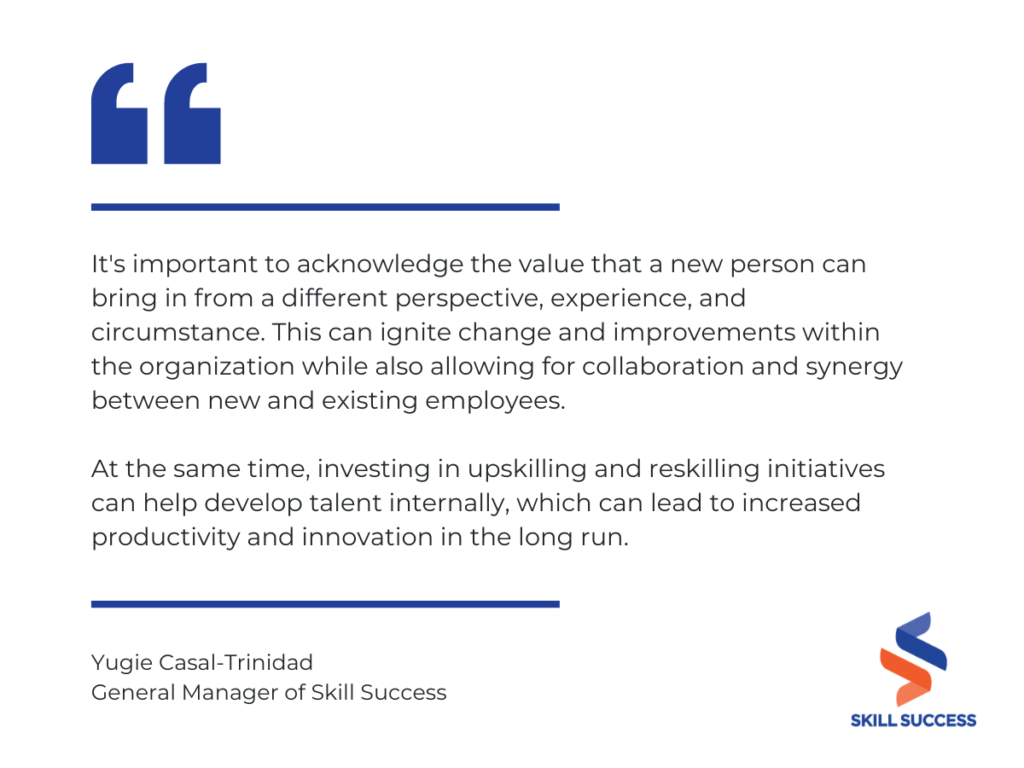
FAQs about Upskilling, Reskilling, and Hiring
Why is upskilling important for employees?
Upskilling helps employees stay relevant in a rapidly changing job market by acquiring new skills that align with industry trends and advancements.
What's the difference between upskilling and reskilling?
Upskilling involves enhancing existing skills, while reskilling requires learning entirely new skills to transition into a different role or industry.
How does reskilling benefit businesses?
Reskilling enables businesses to adapt to evolving demands and seize new opportunities by preparing employees to tackle different roles or tasks.
When is hiring externally preferable over upskilling or reskilling?
Hiring externally is necessary when specific expertise is required immediately, and time constraints don't allow for internal skill development.
How does upskilling contribute to employee retention?
Upskilling demonstrates a commitment to employee growth, fostering loyalty and job satisfaction, which reduces turnover rates and improves retention.
How can businesses ensure a successful upskilling program?
A successful upskilling program involves identifying skill gaps, tailoring training to employees' needs, providing continuous learning opportunities, and measuring the impact of the training on performance.
What role does technology play in upskilling and reskilling?
Technology facilitates accessible and personalized learning experiences, enabling employees to acquire new skills efficiently and stay competitive in the dynamic job market.
Key Takeaways
Facts and Statistics on Upskilling, Reskilling and Hiring in 2023
Top 3 factors to consider when choosing between upskilling, reskilling, and hiring:
- Availability of training resources
- Cost-effectiveness
- Time constraints
Preference for upskilling, reskilling, and hiring:
- Combination of upskilling, reskilling, and hiring: 59.8%
- Upskilling current employees: 15.7%
- Reskilling: 10.3%
- Hiring: 8.5%
Top 3 challenges in implementing upskilling and reskilling programs:
- Finding suitable training resources/providers
- Allocating training budget
- Identifying the right skills to focus on
Importance of lifelong learning:
- 89.5% of respondents find lifelong learning extremely or very important
- 9.7% find it moderately important
- 0.7% see it as not important
Importance of focusing on AI-related skills
- Yes, AI skills are important for future job opportunities: 40.5%
- Yes, but only for specific job roles: 24.3%
- Neutral, AI skills should be balanced with other skills: 32.2%
- No, AI skills are not a priority: 2.9%
The data gathered from surveys and insights shared by experts make it clear that a combination of these approaches holds significant importance. With various factors to weigh and challenges to navigate, decision-makers must carefully apply these strategies based on their unique organizational needs.
Lifelong learning remains a cornerstone for success in this ever-evolving landscape. Among the challenges we discussed, the task of finding suitable training resources and providers stands out. Skill Success provides a wide range of online courses with certificates that can help businesses and individuals upskill, reskill, and develop their skills. Our curated selection spans various domains, including career development, leadership skills, soft skills, and more.
To access the entire library of courses, businesses subscribe to Skill Success All Access Pass. This pass gives businesses unlimited access to all of our courses.
We hope that this article has been helpful in providing businesses with some guidance on how to approach upskilling, reskilling, and hiring in the age of AI. We encourage businesses to take a holistic approach and consider all of their options before making a decision.

